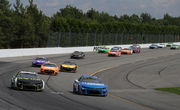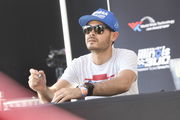
via Imago
CHICAGO, IL – JULY 01: Parker Kligerman 48 Big Machine Racing Spiked Light Coolers Chevrolet is introduced before the NASCAR, Motorsport, USA Xfinity Series The Loop 121 on July 1, 2023, at the Chicago Street Course in Chicago, IL. Photo by John Smolek/Icon Sportswire AUTO: JUL 01 NASCAR Xfinity Series The Loop 121 EDITORIAL USE ONLY Icon23070184 | Image Credits: Imago

via Imago
CHICAGO, IL – JULY 01: Parker Kligerman 48 Big Machine Racing Spiked Light Coolers Chevrolet is introduced before the NASCAR, Motorsport, USA Xfinity Series The Loop 121 on July 1, 2023, at the Chicago Street Course in Chicago, IL. Photo by John Smolek/Icon Sportswire AUTO: JUL 01 NASCAR Xfinity Series The Loop 121 EDITORIAL USE ONLY Icon23070184 | Image Credits: Imago
Those who remember the 2022 Pocono Raceway results know that the battle doesn’t always end at the checkered flag in NASCAR. Sometimes, the real fight happens in the garage, through the rulebook, or even in the appeal room. For drivers and teams, every inch, every rule, and every decision can mean the difference between a trophy and a heartbreak. But what happens when a technicality overshadows an entire race effort? History repeats itself, and it has come back in the form of the first Truck Series race of 2025.
Parker Kligerman and Henderson Motorsports faced a post-race disqualification at Daytona. It’s a bitter pill to swallow, especially after surviving the chaos of superspeedway racing. But as former NASCAR driver Landon Cassill recently pointed out, there may be a sneaky trick drivers have been using to avoid these very penalties—one that raises bigger questions about how NASCAR enforces its rules.
ADVERTISEMENT
Article continues below this ad
Landon Cassill exposes NASCAR’s post-race inspection loophole
When Parker Kligerman finished first in the Craftsmen Truck Series season opener, his No. 75 was disqualified due to failing to meet post-race height regulations. It was a crushing loss for his team, one which took a decent points day away. While fans and commentators bickered about the absolute character of the regulation, Cassill’s tweet added an element of unexpected context to the debate.
“The price of crossing the line in a NASCAR race without any damage is that you must clear post-race heights. Drive it into the fence on the cooldown lap. It’s your only option.” Cassill explained that he had discovered this the hard way in New Hampshire when he drove in unmarked, only to be disqualified on height inspection grounds for being too low. It turned his season around, and it prompted him to switch to a strategic—but suspicious—style at Phoenix when he finished P4. “Later I ran P4 at Phoenix and made sure that didn’t happen again.”
The penalty for finishing a NASCAR race with no damage is that you have to pass post race heights.
Drive it into the fence on the cooldown lap. It’s your only choice. I had no damage in New Hampshire, so they checked my heights: too low, DQ. Later I ran P4 at Phoenix, and made… https://t.co/8ybM6PxeSk— landon cassill (@landoncassill) February 15, 2025
While Cassill himself did not say what he had done, the inference was clear: Drivers on purpose crash their cars after a race so they can cheat on the post-race inspection. This way, they can attribute minor differences in height to damage from a collision rather than a technical violation. Height rules in NASCAR are meant to prevent teams from capitalizing on aerodynamic benefits. A car with a lower ride has better downforce, which can put a team ahead of the game. But how they enforce those rules has been debated for years.
In Parker Kligerman’s case, his No. 75 had come up just a fraction of an inch short on the rear-height measurement. Although NASCAR acknowledged that it was most likely a product of race damage, the penalty still stood. Cassill’s point is that drivers have found a creative loophole—one that, ironically, is intentionally done by causing damage to their own cars after the checkered flag.
What’s your perspective on:
Should drivers intentionally damage their cars to avoid disqualification? Is this the new NASCAR strategy?
Have an interesting take?
Cassill’s comments are a fascinating insight into the NASCAR backroom survival tactics. Rule bending is certainly nothing new in motorsport, but this revelation calls into question the fairness of NASCAR’s post-race tech process. Do minor transgressions—especially those caused by race wear and tear— deserve total disqualification?
To Parker Kligerman, his Daytona DQ was an unpalatable pill, but Cassill’s observation shows that hard-learned experience will teach him the lesson—a lesson already taught by many years of driving veteran competitors. Ultimately, to preserve your finish, you might well need to put your car into the wall first.
Trending
ADVERTISEMENT
Article continues below this ad
Henderson Motorsports Protests Parker Kligerman’s Disqualification Following Daytona Letdown
In 2022, Denny Hamlin and Kyle Busch sped down the Pocono Raceway to gather winning positions, sending racer Bubba Wallace to 3rd. While Bubba was returning home after the race, he received a call telling him that he was the official winner of the race. Meanwhile, at the track, a team of official scrutinizers had found an extra layer of unapproved tape added to the nose in front of the wheel wells of both drivers. Hamlin and Busch got disqualified, crowning a lucky Wallace as the winner. Joe Gibbs Racing was devastated by the blow they had faced. Not one but both their drivers were disqualified.
It resonates strongly with the case for Henderson Motorsports following Parker Kligerman’s disqualification in the NASCAR Craftsman Truck Series race at Daytona. They tweeted: “OFFICIAL UPDATE: We’ve decided to appeal the disqualification of our #75 Truck from last night’s NCTS Race at Daytona.” For Kligerman and the No. 75 crew, the DQ was a gut- punch. He had battled through the superspeedway chaos, dodging wrecks and taking calculated risks to collect a good finish—only to have it taken away due to a post-race inspection failure.
Whereas NASCAR does have stringent height and weight restrictions to guarantee even competition, the decision has caused controversy. Others contend that technicalities, most of which are a direct consequence of the nature of unpredictability of Daytona racing, shouldn’t disqualify the efforts of an entire race. Even ex-NASCAR driver Landon Cassill suggested that drivers will occasionally “self-inflict” damage after a race to escape height penalties.
ADVERTISEMENT
Article continues below this ad
By appealing, Henderson Motorsports is not going quietly into the night, feeling the penalty to be unjust or at least should be reconsidered. Appeals to NASCAR are questionable, but the team is making it clear—they won’t go quietly. All Parker Kligerman and his team can do now is wait and hope. If the appeal stands, it will restore a hard-earned finish. If not, it’s another tough lesson in the unpredictability of NASCAR.
ADVERTISEMENT
ADVERTISEMENT
ADVERTISEMENT
ADVERTISEMENT







Should drivers intentionally damage their cars to avoid disqualification? Is this the new NASCAR strategy?